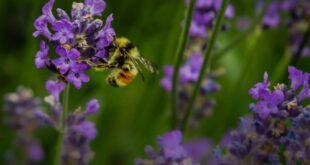Guest contributor Bronco provides an update on how you can help to restore our honey bee population
Honey bee numbers are declining – how we can help
Statistics show that honey bee numbers are dropping significantly in the UK. This is due to a number of factors, such as diseases, parasites, pesticides and habitat loss. Bees play a big part in our eco system and they’re currently needing desperate attention.
Reports show that we have lost 97% of flower rich meadows since the 1930s and that here in the UK we have already lost around 13 species and another 35 bee species are in danger of extinction. Even more worrying is the fact that across Europe, nearly 1 in 10 wild bee species face extinction, meaning that the time to act is now if we want to save these species from extinction.
There are many way in which we can help the bee population and www.thelifeofbees.co.uk has put together this hand guide you can do in your garden to help out.
Choose bee-friendly seeds and plants
Even small gardens can become great havens for bees given the right circumstances and this starts with choosing bee-friendly seeds and plants. There are many plants, wildflowers and herbs to choose from when looking to attract bees to the garden and after all gardening is all about trying new things and choosing nectar and pollen rich plants are crucial to attracting bees to the garden.
Plants that are particularly good choices are Wild Red Clover and Lavender. Wild Red Clover is an essential component of a spring meadow and produces vibrant pink/red clover bulbs which attract a variety of pollinators. Lavender is also a good choice, it is easy to grow and produces purple flowers and a beautiful scent.
Bees are also attract to a number of herbs including sage, thyme and parsley which are easy to grow in pots and don’t take up a lot of space. As always, choose plants and flowers that suit your garden and herbs that you use throughout the year.
Experimentation is key, as the greater variety of plants and flowers you have in the garden the more wildlife and bees they will support.
Bees need shelter too
Just like many types of wildlife in the garden, bees need foraging areas and shelter too, so creating a friendly and safe habitat is key to attracting them to the garden. If you have a lawn, reserve a small area that you leave to overgrow and plant red clover and lavender nearby for an enticing welcome.
Small wood piles also make a great shelter for bees as well as other invertebrates. Gather some old braches and logs (avoid treated wood) and pile it up in a quiet corner of the garden, the best place is under some trees or shrubs because it is cooler there.
There are also a fantastic range of bee houses available to buy, they make great gifts and can be hung just about anywhere in the garden. The added bonus with bee houses is that you can watch them going about their daily lives without have to disturb them.
Put away the pesticides
With so many of our actions as human beings impacting the environment and wildlife in particular, it is vital that we take care when choosing chemicals and materials to use in our gardens. Avoid using pesticides in the garden at all, there are plenty of non-toxic and homemade alternatives available to get rid of unwanted pests.
Making your own compost is a great way to recycle your left over food and cuttings, while encouraging a huge variety of wildlife into the garden. Composting has been shown to improve the soils structure, making it a great breeding ground for bees and other invertebrates; it can also promote the growth of plant and flowers helping them to stay healthy.
 Gardeners Club The Gardeners Club is a free to join online club for everyone with an interest in gardening and gardens.
Gardeners Club The Gardeners Club is a free to join online club for everyone with an interest in gardening and gardens.






